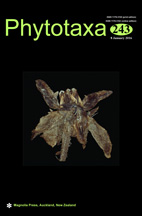Abstract
Falcula hyalina Takano (1983: 24) is an epizoic diatom commonly associated with coastal copepods in many parts of the world (Takano 1983, Mahoney & Gibson 1983, Hiromi et al. 1985, Prasad et al. 1989, Souza-Mosimann et al. 1989, Fernandes & Calixto-Feres 2012, Li et al. 2014). The species was described and illustrated using the transmission electron microscope by Takano (1983) who differentiated it from other taxa of the genus—F. rogallii Voigt (1960: 86), F. media Voigt (1960: 87), F. semiundulata Voigt (1960: 87), F. paracelsiana Voigt (1961: 54) and F. media var. subsalina Proshkina-Lavrenko (1963: 36)—by the morphometric features of the valve (length, width, and stria and areolae density). Some years later, Prasad et al. (1989) improved the morphological features of F. hyalina using the scanning electron microscope and discussed the relation of the species with similar taxa. Round et al. (1990), in the diacritic description of the genus, raised the question that F. hyalina had some features that could not match with Falcula, such as the wider sternum and poroidal apical pore field (ocellulimbus), as opposed to a series of slits at the apices. Therefore, the taxonomic position of F. hyalina still remains uncertain.

